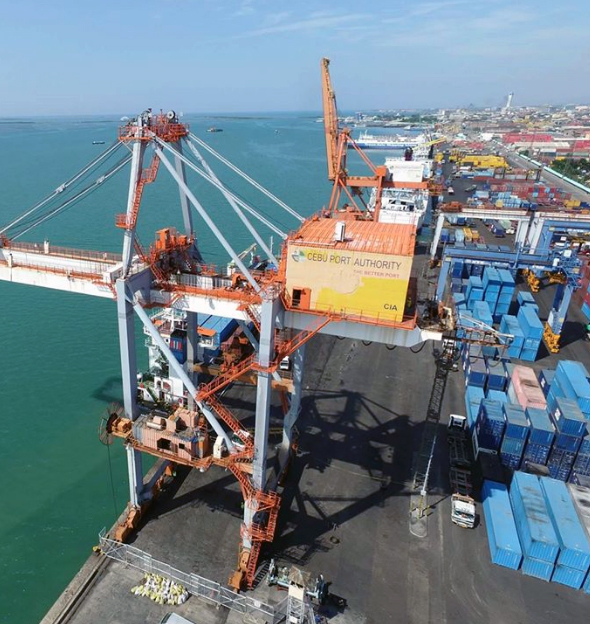The Cebu Port Authority (CPA) was created through the enactment of Republic Act No. 7621 signed on 26-June-1992 to specifically administer all ports located in Cebu Province, thus, effectively separating these ports from the Philippine Ports Authority (PPA). On 01-January-1996, CPA began operations and officially took over all Cebu ports.
The territorial jurisdiction of the CPA includes all ports, seas, lakes, rivers and all other navigable inland waterways within the province of Cebu, the City of Cebu, and all other highly urbanized cities that may be created after the enactment of R.A. 7621.
The Cebu City Baseport is located along the Mactan Channel, a narrow strait between Cebu and Mactan Islands.
The Cebu International Port covers a 14-hectare area, consisting of 512 meters (1,680 ft) of berthing space with 1,953 TEU ground slots, 204 refrigerated container plugs, and a bulk handling terminal.
The Cebu Domestic Port covers a 21-hectare area, with 3,838 meters (12,593 ft) of berthing space, 3 piers, 3 passenger terminals for inter-island trips, and 2 ferry terminals for Cebu City–Mactan ferry boats.
Its 2,688 sqm (28,930 sq ft) Passenger Terminal started regular operations on 21-November-2014. It is fully air–conditioned, with a spacious lobby that houses the Port Management Office, a send-off area, canteen, and Wi-Fi internet connection.
The new General Manager of CPA is Leonilo E. Miole. He replaced the late Angelo Verdan who passed away on 5-June-2019. The Cebu Port Commission (CPC), the governing body of the CPA, elected Miole as the new GM of CPA. Miole took his oath of office on 18-July-2019. Concurrently, Miole sits as Vice Chairman of the CPC. Prior to joining CPA, Miole had been with the Philippine Ports Authority as Port Manager of Davao.
During the previous GM Angelo Verdan’s time in office, he said a new Cebu container port would be built and ready by 2022. The Philippines and South Korea had signed a US$172.64M loan agreement with EXIM’s Economic Development Cooperation Fund to construct an international port in Cebu to free up cargo traffic in the Cebu City seaport, the largest domestic port in the Philippines. In so doing, the new international port would provide a more efficient and reliable port infrastructure in the Visayas. The Philippines would provide a counterpart funding of $26.09M.
 The new port would be built on a 25-hectare reclaimed land in the town of Consolation, Cebu. The project includes a berthing facility with a 500-meter long quay that can accommodate two 2,000 TEU vessels; operating facilities such as freight station, inspection shed; access road and bridge; dredge waterway; a turning basin; as well as cargo handling equipment.
The new port would be built on a 25-hectare reclaimed land in the town of Consolation, Cebu. The project includes a berthing facility with a 500-meter long quay that can accommodate two 2,000 TEU vessels; operating facilities such as freight station, inspection shed; access road and bridge; dredge waterway; a turning basin; as well as cargo handling equipment.
Last year, the CPA had to expand berths 7 and 8 of the Cebu City Baseport to allow the use of quay cranes in the domestic containerized cargo operations in an effort to help reduce the chronic congestion problem on the domestic side of its port operations.
